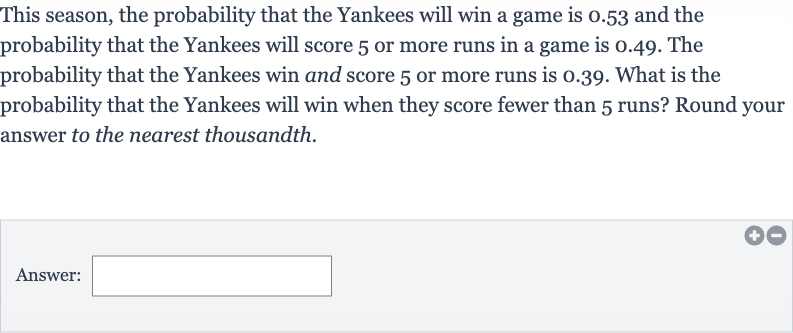AI tutor
Welcome to Bytelearn!
Let’s check out your problem:

This season, the probability that the Yankees will win a game is . and the probability that the Yankees will score or more runs in a game is . . The probability that the Yankees win and score or more runs is . . What is the probability that the Yankees will win when they score fewer than runs? Round your answer to the nearest thousandth.Answer:
Full solution
Q. This season, the probability that the Yankees will win a game is . and the probability that the Yankees will score or more runs in a game is . . The probability that the Yankees win and score or more runs is . . What is the probability that the Yankees will win when they score fewer than runs? Round your answer to the nearest thousandth.Answer:
- Events Denoted: Let's denote the events as follows:W: The Yankees win a game.S: The Yankees score or more runs in a game.We are given the following probabilities: (Probability that the Yankees will win a game) (Probability that the Yankees will score or more runs in a game) (Probability that the Yankees win and score or more runs)We need to find the probability that the Yankees will win when they score fewer than runs, which can be denoted as .
- Find Probability not S: First, we need to find the probability that the Yankees score fewer than runs, which is the complement of the event . The complement rule states that .So, .
- Calculate : Now, we can use the formula for conditional probability to find , which is the probability that the Yankees win given that they score fewer than runs. The formula is:We already have , but we need to find . We can find this by subtracting from , because includes all wins, both with or more runs and with fewer than runs.So,
- Round to Nearest Thousandth: Now we can calculate using the values we have: Calculating this gives us
- Round to Nearest Thousandth: Now we can calculate using the values we have: . Calculating this gives us .We round the answer to the nearest thousandth as requested: .
More problems from Find probabilities using the addition rule
QuestionGet tutor help
QuestionGet tutor help
QuestionGet tutor help
QuestionGet tutor help
QuestionGet tutor help
QuestionGet tutor help
QuestionGet tutor help
QuestionGet tutor help
QuestionGet tutor help


